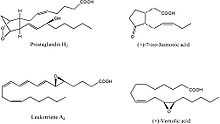Oxylipin

Oxylipins constitute a family of oxygenated natural products which are formed from fatty acids by pathways involving at least one step of dioxygen-dependent oxidation.[1] Many of oxylipins have physiological significance.
Oxylipins are widespread in aerobic organisms including plants, animals and fungi. Typically, oxylipins are not stored in tissues but are formed on demand by liberation of precursor fatty acids from esterified forms.
Biosynthesis of oxylipins is initiated by dioxygenases or monooxygenases; however also non-enzymatic autoxidative processes contribute to oxylipin formation (phytoprostanes, isoprostanes). Dioxygenases include lipoxygenases (plants, animals, fungi), heme-dependent fatty acid oxygenases (plants, fungi), and cyclooxygenases (animals). Fatty acid hydroperoxides or endoperoxides are formed by action of these enzymes. Monooxygenases involved in oxylipin biosynthesis are members of the cytochrome P450 superfamily and can oxidize double bonds with epoxide formation or saturated carbons forming alcohols. Nature has evolved numerous enzymes which metabolize oxylipins into secondary products, many of which possess strong biological activity. Of special importance are the cytochrome P450 enzymes in animals, including CYP5A1 (thromboxane synthase), CYP8A1 (prostacyclin synthase), and the CYP74 family of hydroperoxide-metabolizing enzymes in plants, lower animals and bacteria. In the plant and animal kingdoms the C18 and C20 polyenoic fatty acids, respectively, are the major precursors of oxylipins.
Oxylipins in animals, referred to as eicosanoids (Greek icosa; twenty) because of their formation from twenty-carbon essential fatty acids, have potent and often opposing effects on e.g. smooth muscle (vasculature, myometrium) and blood platelets. Certain eicosanoids (leukotrienes B4 and C4) are proinflammatory whereas others (resolvins, protectins) are antiinflammatory and are involved in the resolution process which follows tissue injury. Plant oxylipins are mainly involved in control of ontogenesis, reproductive processes and in the resistance to various microbial pathogens and other pests.
References
- ↑ Gerwick WH, Moghaddam M, Hamberg M (1991). "Oxylipin metabolism in the red alga Gracilariopsis lemaneiformis: mechanism of formation of vicinal dihydroxy fatty acids". Arch. Biochem. Biophys. 290 (2): 436–44. doi:10.1016/0003-9861(91)90563-X. PMID 1929410.